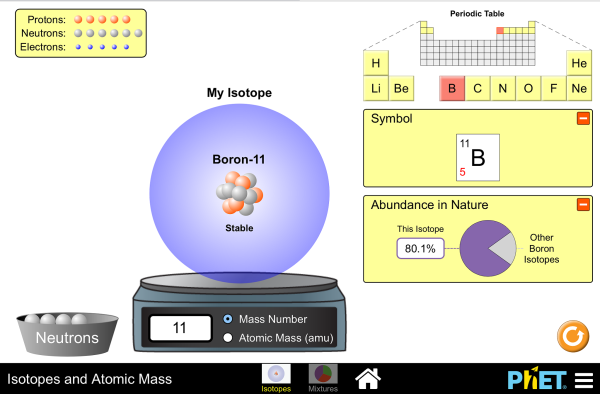Goal:
Gather evidence for how stars produce new chemical elements.
Agenda:
Warmup
Video
Storyboard
Warmup
In your journal entry from yesterday, write an argument in the form of a CER paragraph answering the question: Is alpha decay a form of nuclear fission?
Video
We need to answer the question: Where do all of the elements on Earth come from? Use this video to gather evidence to answer that question.
Storyboard
Work with a partner and create a storyboard for how stars form elements. Make sure your storyboard addresses the following questions:
Of all the changes, why nuclear fusion? Of all the places, why stars?
Thursday, November 10, 2016
Wednesday, November 9, 2016
Nuclear Fission
Goal:
Use models to compare and contrast fission and alpha decay in terms of how the nucleus changes.
Agenda:
Warmup
Fission Simulation
Stop Motion Video
Warmup
Socrative Quiz
Fission Simulation
Create a new journal entry entitled "Fission." I will show you the fission simulation. As we watch fission I would like you to write a description of what happens before a nuclear fission reaction. Use these questions to guide your description:
Use models to compare and contrast fission and alpha decay in terms of how the nucleus changes.
Agenda:
Warmup
Fission Simulation
Stop Motion Video
Warmup
Socrative Quiz
Fission Simulation
Create a new journal entry entitled "Fission." I will show you the fission simulation. As we watch fission I would like you to write a description of what happens before a nuclear fission reaction. Use these questions to guide your description:
- What are the particles BEFORE the reaction? How many are there?
- What are the particles AFTER the reaction? How many are there?
Stop Motion Video
You will work with a partner for this. One of you will download Stop Motion Studio if you don't have it already. Create a stop motion video modeling either alpha decay or nuclear fission. Try to finish by the end of the class period.
Tuesday, November 8, 2016
Nuclear Equations
Goal:
Use nuclear equations as a model to describe how the nucleus changes in alpha and beta decay.
Agenda:
Warmup - Pop Quiz
Notes
Practice
Exit Slip
Warmup
Get out a sheet of paper and answer the following questions:
Practice
Open this document in Notability and answer the questions.
Use nuclear equations as a model to describe how the nucleus changes in alpha and beta decay.
Agenda:
Warmup - Pop Quiz
Notes
Practice
Exit Slip
Warmup
Get out a sheet of paper and answer the following questions:
- What makes atoms radioactive? Describe this in terms of protons, neutrons, and stability.
- How do alpha and beta decay change the nucleus?
- How do alpha and beta decay make the nucleus more stable?
Notes
Practice
Open this document in Notability and answer the questions.
Monday, November 7, 2016
Stability of Atoms
Goal:Use models to describe what makes an atom radioactive in terms of stability, protons, and neutrons.
Agenda:
Warmup
Isotopes Phet
Stability Chart
Exit Slip
Agenda:
Warmup
Isotopes Phet
Stability Chart
Exit Slip
Warmup
Work with your team on whiteboards.
Study the following models of alpha decay. For each example, write down the number of protons and neutrons for each atom before and after the change. What is the pattern in how the nucleus changes for alpha decay?
Study the following models of beta decay. For each example, write down the number of protons and neutrons for each atom before and after the change. What is the pattern in how the nucleus changes for beta decay?
Isotopes Phet
Work with your team on whiteboards.
Study the following models of alpha decay. For each example, write down the number of protons and neutrons for each atom before and after the change. What is the pattern in how the nucleus changes for alpha decay?
Study the following models of beta decay. For each example, write down the number of protons and neutrons for each atom before and after the change. What is the pattern in how the nucleus changes for beta decay?
Isotopes Phet
Using the Phet simulation, try to answer the question: What makes an atom unstable?
Stability Chart
In your science journal, create a new entry entitled "Stability Chart." Copy and paste the chart below into your journal and use it to answer the questions.

Stability Chart
In your science journal, create a new entry entitled "Stability Chart." Copy and paste the chart below into your journal and use it to answer the questions.
A: Write down 3 observations describing the chart.
B: What does this graph tell us about the stability of atoms?
C: Use the graph to predict if the following atoms are stable. State WHY you think they are unstable based on the graph.- An atom with 20 protons and 20 neutrons.
- An atom with 100 protons and 100 neutrons.
- An atom with 80 protons and 120 neutrons.
- An atom with 60 protons and 40 neutrons.
- An atom with 40 protons and 80 neutrons.
D: Propose a stable atom. Write the following information about the proposed atom:
- Element Name
- # of Protons
- # of Neutrons
At the top of your journal entry, write a CER paragraph to answer the following question:
Why do you think atoms are radioactive?
Subscribe to:
Comments (Atom)

